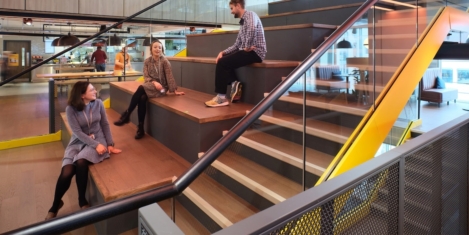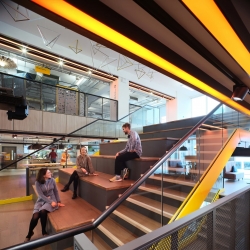May 5, 2022
Retrofit is essential for the UK’s stock of poor performing commercial property
 The UK Green Building Council (UKGBC) has published a guide that calls on businesses to retrofit the country’s poorly performing stock of commercial buildings. From 2025, every commercial building in the UK will require an energy performance certificate (EPC) which rates its energy efficiency from grade A to G. The Government is seeking to strengthen these standards and has proposed that all commercial properties being let have a minimum EPC rating of at least ‘B’ by 2030 and is considering a possible interim requirement of level ‘C’ by 2027. Buildings which fail to meet these new standards would require owners and landlords of commercial buildings to upgrade their stock. More →
The UK Green Building Council (UKGBC) has published a guide that calls on businesses to retrofit the country’s poorly performing stock of commercial buildings. From 2025, every commercial building in the UK will require an energy performance certificate (EPC) which rates its energy efficiency from grade A to G. The Government is seeking to strengthen these standards and has proposed that all commercial properties being let have a minimum EPC rating of at least ‘B’ by 2030 and is considering a possible interim requirement of level ‘C’ by 2027. Buildings which fail to meet these new standards would require owners and landlords of commercial buildings to upgrade their stock. More →










 Six workplaces across the North of England and Northern Ireland have been recognised at the annual British Council for Offices (BCO) Regional Awards today. The Northern BCO Awards dinner returned in-person to the Kimpton Clocktower in Manchester, recognising the North’s highest quality developments and setting the standard for excellence in the office sector across the UK.
Six workplaces across the North of England and Northern Ireland have been recognised at the annual British Council for Offices (BCO) Regional Awards today. The Northern BCO Awards dinner returned in-person to the Kimpton Clocktower in Manchester, recognising the North’s highest quality developments and setting the standard for excellence in the office sector across the UK. 


 Six London workplaces have been recognised at the annual British Council for Offices’ (BCO) Regional Awards. The London Awards Lunch returned in-person to the London Hilton on Park Lane, recognising the highest quality developments in London and setting the standard for excellence in the office sector across the UK. The winning workplaces include: 80 Charlotte Street (Commercial Workplace); Plumtree Court, 25 Shoe Lane (Corporate Workplace); Dojo, The Brunel Building, 2 Canalside Walk (Fit Out of Workplace); ASOS HQ, Greater London House, 180 Hampstead Road (Refurbished/Recycled Workplace); Pennybank , 33-35 St John’s Square (Projects up to 1,500m sq. ); 1 Triton, 1 Triton Square, Regent’s Place (Innovation)
Six London workplaces have been recognised at the annual British Council for Offices’ (BCO) Regional Awards. The London Awards Lunch returned in-person to the London Hilton on Park Lane, recognising the highest quality developments in London and setting the standard for excellence in the office sector across the UK. The winning workplaces include: 80 Charlotte Street (Commercial Workplace); Plumtree Court, 25 Shoe Lane (Corporate Workplace); Dojo, The Brunel Building, 2 Canalside Walk (Fit Out of Workplace); ASOS HQ, Greater London House, 180 Hampstead Road (Refurbished/Recycled Workplace); Pennybank , 33-35 St John’s Square (Projects up to 1,500m sq. ); 1 Triton, 1 Triton Square, Regent’s Place (Innovation) 


 Employees with full autonomy to choose where they work are happier in their job, yet only one in five are currently able to do so. And though 60 percent of all employees prefer hybrid working, only 39 percent are able to flexibly split their time between the home and office. This is according to Jabra’s 2022 edition of the
Employees with full autonomy to choose where they work are happier in their job, yet only one in five are currently able to do so. And though 60 percent of all employees prefer hybrid working, only 39 percent are able to flexibly split their time between the home and office. This is according to Jabra’s 2022 edition of the 













May 9, 2022
Human resources professionals should focus on boardroom partnerships
by Jeanette Wheeler • Comment, Workplace